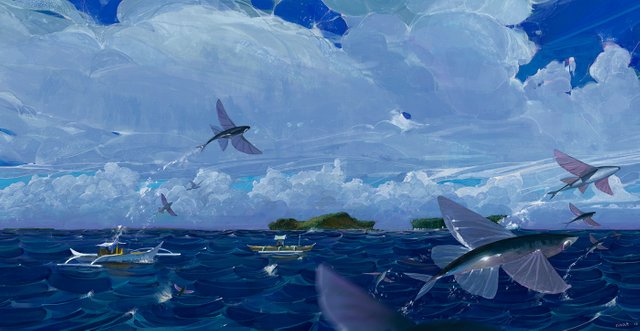What if Columbus did not swim to America?
The discovery of America in 1492 was a disaster for Native American societies and turned European history. The New World was almost another planet: a territory that no one knew about before, a land ready for occupancy, which only minimal efforts were needed to conquer - so great was the technological gap. Columbus's journey was a risky and expensive project that could easily have ended in failure. How would the story turn in this case?

On August 2, 1492, three ships sailed from the Spanish port of Palos de la Frontera in search of a new route to India and China. The squadron was led by Genoese Cristobal Colon (Christopher Columbus). Columbus's project has grown out of a simple and obvious to us thought: once the Earth is in the shape of a sphere, then, having sailed from any Spanish port and following strictly to the west, the patient navigator will sooner or later reach the coast of Asia.
Thanks to Marco Polo's notes about the journey to the court of Khubilai Khan, 15th-century Europeans believed that the eastern coast of Asia was fenced off from the Great Ocean by a whole scattering of large and small islands, among which Chipangu Island (Japan), ruled by a sovereign monarch, stands out. What kind of data formed the basis of these words? Relatively reliable stories of Chinese sailors about their voyages to the country of Fusan (Sakhalin) and Japan? Arab and Indian seafarers' information about the islands of Indonesia and the Philippines? Reached the court Kubilaya stories about Kamchatka, Kuriles or islands of Oceania? In his notes, Polo reported that about 4 thousand islands are located near the east coast of Asia. It was them that Columbus wanted to find: he believed that these islands occupy a significant part of the Great Ocean, and the distance from Spain to Japan directly across the ocean is three times less than what it turned out to be in reality.

For the Renaissance, Columbus was one of the most enlightened people. His ideas about the structure of the world were based on the writings of Strabo, Seneca, Ptolemy and Pythagoras, which were actively published in the 15th century.
He was also known for the works of his contemporaries, who relied on the ancient classics. For example, Pierre d’Ayi, a French cosmographer and geographer of the early 15th century, describing the sphericity of the Earth and referring to Seneca, indicated that the ocean is narrow and the journey from Spain to India will take several days. In his copy of the work of d’Ai Columbus wrote:
"It makes no sense to believe that the ocean covers half of the Earth."
His views were not some sort of marginal thought. Moreover, as the British historian Hugh Thomas wrote in his book The Rise of the Spanish Empire, the idea that the Earth was a ball was accepted by the Catholic Church at the beginning of the VIII century. And thanks to religious education, this concept sat very tightly in the heads of the ruling elites of Europe, which included Fernando of Aragon and Isabella of Castile, the king and queen of Spain, who sponsored the Genoese.

Of course, the enlightened monarchs helped Columbus not unselfishly. By allocating money for his expedition, they hoped to get in return a shorter way to get to India than the already known - through Africa. This path was in the hands of the Portuguese and brought them money and spices already at the expense of the exploitation of African wealth and the trade in black slaves alone.
To allow India to fall into the hands of the Portuguese, the Spanish monarchs could not and took part in a risky venture. They tried to provide Columbus with all the necessary, but they faced the same problem that any investor solves today: how to balance risk and benefit by investing in such an unreliable business? On the one hand, the amount given to Columbus should have been enough to reach India, or at least go back from the middle of the road. On the other hand, in the event of the failure of the expedition, the money should have been absolutely not a pity.
The Catholic monarchs found an elegant way out of the situation: by giving Columbus money, documents and permits for a series of actions, they obliged the city of Palos to give him ships from their own funds and crews to them.

Thus, the legendary “Santa Maria”, “Pinto” and “Ninja” authorities of Palos did not transfer to Columbus completely voluntarily, and their team was staffed with people whose adventurism could turn out to be higher than professionalism.
So, on August 2, 1492, Columbus left Palos. The ships arrived in the Canary Islands, which belonged to Spain: first, the Canaries were the last Spanish frontier in the Atlantic, and second, it was from them that favorable winds began to blow to the New World of the wind, which Columbus wanted to use. September 6, 1492 after repair and rest before it is unknown how long the expensive expedition leaves the Canary port of La Gomera and goes west.
Now let's imagine that Christopher Columbus did not come back, and his tracks were lost forever in the vast expanses of the Atlantic Ocean. It’s not so important why this could happen - after all, the Atlantic was full of various risks for the navigator: Portuguese and French privateers, merciless Arab pirates, sailor’s riot or even the Sargasso Sea, the dangers of which were described in the novel Island of the Dead Ships. Alexander Belyaev.
You got a 1.82% upvote from @minnowvotes courtesy of @kuku12170!